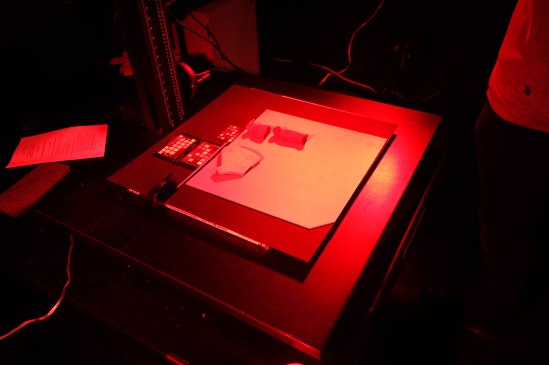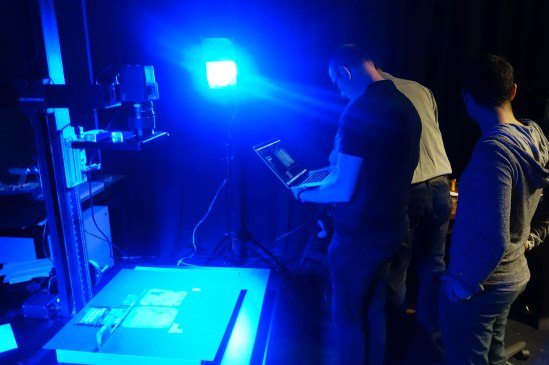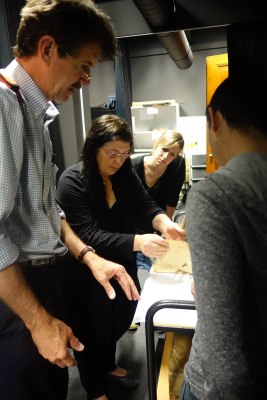Tag Archives: General
Microdome imaging workshop at the J.P. Getty Museum
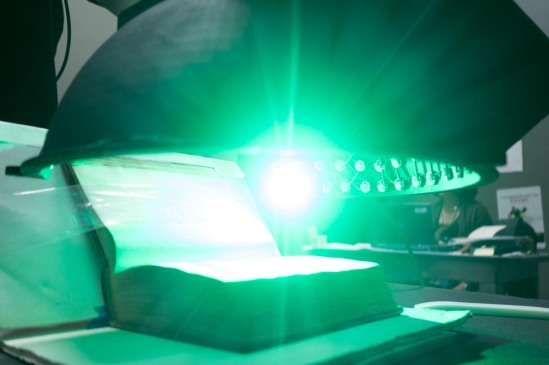 Between January 27th and February 3th the RICH team has been working together with the scientists and conservators of the J.P. Getty Museum and Research Institute in Los Angeles. Various artifacts of the Museum collection have been monitored and studied with Photometric Stereo such as medieval manuscripts, master drawings, bookbindings and daguerreotypes.
Between January 27th and February 3th the RICH team has been working together with the scientists and conservators of the J.P. Getty Museum and Research Institute in Los Angeles. Various artifacts of the Museum collection have been monitored and studied with Photometric Stereo such as medieval manuscripts, master drawings, bookbindings and daguerreotypes.
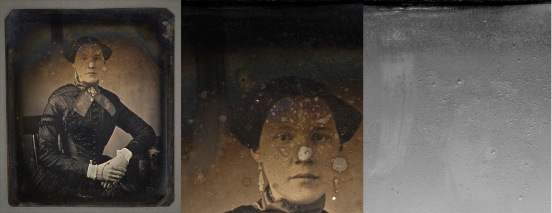
A daguerreotype by Jacob Byerly (1807-1883); left full image made with the White Light Microdome; middle a detail with raking light; right same detail with shaded filter showing degradation. Click on the image to enlarge; collection J. P. Getty Museum
Both White Light and Multi-Spectral Microdomes have been used. The RICH Project, the technical background and the research targets have been highlighted the on February 2nd during the lecture: Microdomes and Manuscripts: Multi-Spectral and Photometric Stereo Imaging for Illuminations, Drawings and Documentary Heritage. After the lecture, a hands-on workshop was given at the Imaging Studio of the Getty Center.

Mira Calligraphiae Monumenta (Georg Bocskay & Joris Hoefnaegel, 1561-62), folio 33; image with White Light Microdome, collection Getty Museum

Mira Calligraphiae Monumenta (Georg Bosky & Joris Hoefnaegel, 1561-62), detail, folio 33; Multi-Spectral Microdome; top left shaded filter; top middle Infrared light (850 nm); top right Red light (623 nm); below left Green light (523 nm); below middle Blue light (460 nm), below right UV light (365 nm)
Workshop on multispectral imaging
The past days (May 11-13) the RICH team organized a workshop on multispectral imaging at the Imaging Lab of the University Library KU Leuven, which coincides with the implementation of the Multispectral Microdome. Mike Toth, Bill Christens-Barry and Alberto Campagnolo set up their imaging system for multispectral capture developed during the Archimedes Palimpsest project. Eric Joakim of Phase One kindly provided an IQ260 Achromatic digital back and IXR camera for capture.

Mike Toth, Lieve Watteeuw, Alberto Campagnolo, Bruno Vandermeulen, Bill Christens-Barry and Eric Joakim, photo Mike Toth
Western and eastern paper, parchment and papyrus documents and archaeological objects such as Egyptian execration statuettes were monitored. These objects were captured through 16 different spectral bands, ranging from UV to IR. We were specifically looking at censored, deleted and faded texts, pictorial layers and false color visualisation of polychrome layers of medieval illuminations.
The Timbuktu manuscripts, which are being researched and digitized at the moment at the Imaging Lab, were also the focus of attention.
RICH presents the new Multispectral Microdome
Today the RICH team presented the first preliminary results of a Microdome with multispectral RTI capability at the Digital Humanities Spring Session (KU Leuven, April 28-29).
The new Multispectral Microdome is equipped with 228 different LED lamps. Five different spectra are evenly distributed over the dome: UV at 365 nm, Blue at 460 nm, Red at 523 nm, Green at 623 nm and IR at 850 nm. A black and white sensor of 28 Mp with extended sensitivity in UV and IR is mounted on top of the dome. After first analysis, the software will be fine-tuned and further enhanced.
Manuscript: KU Leuven, Tabularium, MS 1007, folio 41V
RICH: new research prototype installed. Mounting the Microdome on the Conservation Copy Stand

Manfred Mayer (University Graz), Marc Proesmans (ESAT, KU Leuven) and Lieve Watteeuw (Illuminare, KU Leuven) inspecting the new Microdome and Conservation Copy Stand after successful integration.
In the workflow of the RICH project – on April 14-15, Ir. Manfred Mayer (University Graz) installed a Conservation Book Cradle in the Digital Lab of the KU Leuven, University Library in collaboration with the RICH project team. The well-known Graz book conservation cradle has been specially adapted and reinforced to mount the new “Microdome”, the third generation KU Leuven dome prototype the RICH project is developing. To guaranty the manipulation and integrity of the historical documents during the RICH imaging, the camera-arm can move in an X, Y and Z-axis, so we can position the Microdome very precisely above the document area we are imaging. Precisely, the Microdome hovers about 5 mm above the paper or parchment to be monitored.
The Microdome is smaller than the Minidome we were using up to now (with a diameter of 600 mm). It has a diameter of 300 mm and is fitted with 220 white LED-lamps. A slice (30 °) of the Microdome can be taken away, to monitor and image into the binding and the gathering folds of historic books. The frame above hemisphere enables to mount the Microdome onto the Conservation Copy Stand.
The new tool is flexible and able work in situ historic library and archive collections: we can mount the Microdome on a sturdy tripod or studio stand in order to position it in relation of the object we are monitoring (manuscripts, panel painting, wood, …).
In May 2014 we will test the new Microdome, after the software has been adapted to the new position of the lights.
PLD@Mesopotamia
The Portable Light Dome, developed at the KU Leuven (Belgium), has been used to image Mesopotamian Cultural Heritage since the last decade in museums, university collections and archaeological excavations. Throughout this period several thousands of cuneiform tablets, seals & seal impressions, figurines, pottery and many other archaeological artifacts have been and are still being scanned, studied and published with the help of the Portable Light Dome (PLD). Successively, these efforts have been made via various projects funded by Research Fund KU Leuven, Herculesstichting, Programme Financing KU Leuven and Interuniversity Attraction Poles Belgium.
more info: http://www.arts.kuleuven.be/info/ONO/Meso/digitalisatie
RICH: Reflectance Imaging for Cultural Heritage
The RICH project (Reflectance Imaging for Cultural Heritage) aims to create a unique digital imaging tool for researching, studying, and exploring material characteristics of art and library materials in medieval and early modern times. An imaging device, IMROD (Imaging Module for Multi-spectral, Reflectance Or 3D), will be developed to produce a digital 2D+ record, through multidirectional and multispectral lighting sequences. Reflectance imaging, combined with the possibility to apply virtual illumination, enables the exploration of the material and structures in an interactive manner. A web portal will be implemented for valorisation and dissemination of the research. RICH aims to be an indispensable tool for research and understanding the material and tactile characteristics of art. RICH is a collaboration between four KU Leuven partners: Illuminare (Research Center for Medieval Art) is the promotor, ESAT-Visics, CS/Media and the University Library. Third party is the Museum Plantin-Moretus, Antwerp, Unesco World Heritage. The project started in July 2012 with a Hercules grant and will develop the next 3 years.

